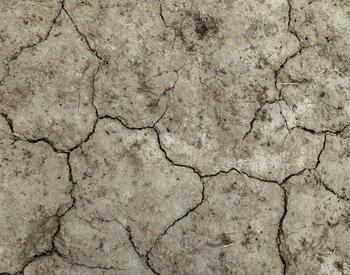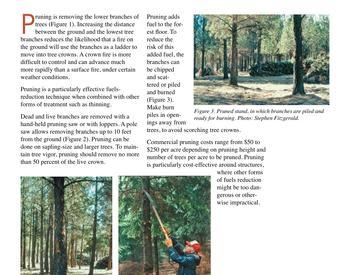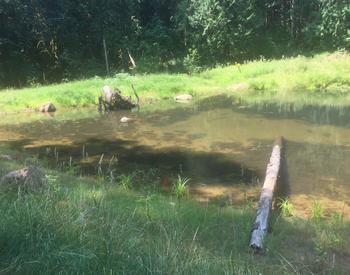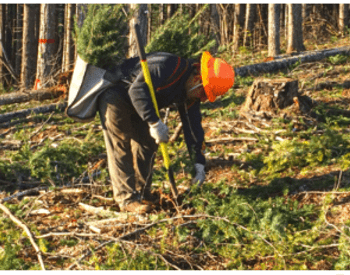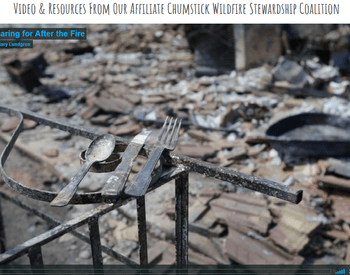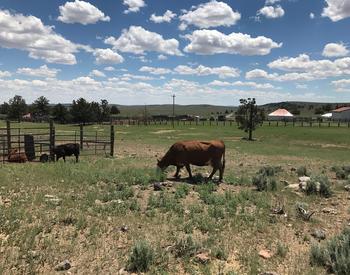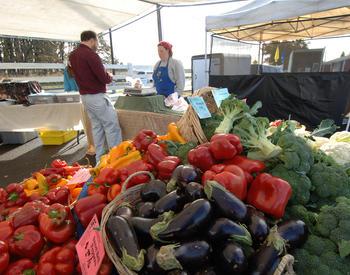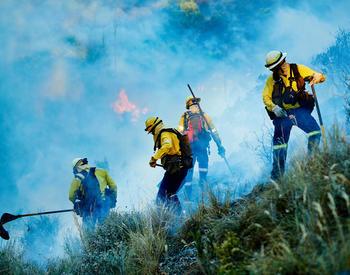Transcript
From the Oregon State University's Extension Service, you are listening to "In the Woods" with the Forestry and Natural Resources Program. This podcast aims to show the voices of researchers, land managers, and members of the public interested in telling the story of how woodlands provide more than just trees, they provide interconnectedness that is essential to your daily life. Stick around to discover a new topic related to forests on each episode.
Lauren Grand: Hi everyone and welcome back to another episode of In the Woods. I'm your host today Lauren Grand, assistant professor of practice and Extension agent in Oregon State University's College of Forestry. Today's topic is forest fungi! Joining me today is a super fun gal, Ariel Cowan, who is going to help us get excited about the fungus among us. Okay, I had to use that joke once at least in the podcast. So, welcome Ariel.
Ariel Cowan: Thank you, thanks so much, Lauren, for having me.
Lauren: Sure. Ariel is joining us today from Oregon State University's Forestry and Natural Resources Extension Fire Team, where she's the regional specialist for the Central region. She's also an assistant professor of practice in the College of Forestry. She has a Bachelor's of Science from the State University of New York College of Environmental Science and Forestry and a Master's degree from Oregon State University's College of Forestry in Forest Ecosystems and Society.
Okay, so I'm so excited about this topic because there's fungus everywhere, and I always get really excited when I see all the different mushrooms in the forest. What sparked your interest? And how did you get excited about forced fungi?
Ariel: That's a great question. Honestly, my interest in the topic of fungi and fungal ecology started back when I went to college for my undergraduate degree in upstate New York. And at the time, I just wanted to broadly study different ecology topics. I was fascinated by how different organisms interact with their environment, and I didn't even really know about fungi or mushrooms until I saw that there was a class I had an option to take, a class in mycology, which is the study of fungi.
And I had this great professor, who was actually originally from Ireland, and so he pronounced fungi "fun-guy" instead of "funj-eye", which, you know, there's no wrong way to pronounce it. But I kind of pronounce it the same way he does in sort of an honor to him. And just, you know, whenever you have a professor who's really enthusiastic about a topic, it can really definitely it can really change your path in life, that then you become more interested.
I also found it really neat that there are all these different culinary mushrooms out there. So, just learning more about the world of fungi. I was fascinated by different stories like how they can be used in rituals id ancient civilizations. They can be both beneficial or a pathogen in forests. There's stories of how they may have influenced the story of Saint Nicholas. I mean, think about it, a large guy flying through the sky at night.
Lauren: Right!
Ariel: Red and white colors, you know, to Saint Nick's outfit, so kind of appropriate timing for that that story, but I definitely encourage folks to look that up, and...
Lauren: That's great, I had not heard that story before.
Ariel: Yeah, and just in general that fungi are, they're kind of like the the outcasts. They're odd, they're, you know, not completely understood. Sure they've been studied for many, many years, but there's still so much that we don't know and don't understand about how they work. So, because of that I just found it to be a fun challenge to focus on studying fungi.
Lauren: And you did, right? When you went into graduate school, you kept it with you as part of your graduate research, is that right?
Ariel: That's right, yeah. So, I had, back in undergrad, had studied different types of fungi and then became more interested in mycorrhizal fungi, which are the kinds that create a beneficial association with trees. And they, even though I had studied them in undergrad, I then went on to do various habitat restoration and biology jobs, but then I realized I wanted to go back to school so I could get more into studying more specifics about mycorrhizal ecology. So, then, when I went back, was a there was an opportunity to mash up these two worlds that I'm passionate about which is mycology and fire ecology.
So, with the work that I had done in graduate school, I had looked at how different levels of fire intensity affected not only the soil, but also the microbes in the soil. More specifically, the beneficial fungi that are growing on the roots of pine seedlings.
Lauren: Great, I hope we get to talk about that a little bit later when we talk about fire and fungi.
Ariel: Definitely.
Lauren: So, we've talked, you mentioned a type of fungus it sounds like, and that fungus is sort of mysterious. So, for those of us who don't spend a lot of time learning and reading about funguses, what's sort of a simple definition? You know, a lot of people probably mistake it as a type of plant often, or... But it's but it's not a plant, what is it?
Ariel: Right, well, you know, this is a fun little challenge of trying to find a simple definition of what a fungus is, but basically it's a heterotrophic organism.
Lauren: What does that mean?
Ariel: Well, they get their food from other sources, that's different than plants. Plants create their own food, and so a fungus will take advantage of, whether it be plants, or other organisms to get their food. They can also be unicellular or multicellular, creating filaments, or strands of cells. So, they can be microscopic or they can be as big as that famous humongous fungus that stretches for miles and miles. They also are unique because they spread through spores, and there are various different types of spores that help to identify the different fungal species that are out there.
So, fungi really they're so unique that they have their own kingdom. There's all the different kingdoms of life out there, you know plants, animals, but then there's this kingdom that's specifically for fungi, in terms of how, you know, what the characteristics are that describe them. But, you know, that kingdom includes not only the mushrooms that you know that you can buy in the store, but also molds, pathogens, endophytes, those are types of fungi that can grow within the leaves of plants. So, it's a really broad group.
Lauren: That's so interesting! And it helps bring you back to like 12th grade biology reminding us of all the kingdoms. And they seem, so they still seem a little mysterious, you know, they're not something that we talk about or think about often. So, and I know that we mostly think about mushrooms when we think about fungi, and probably like you said the mushrooms that that we buy in the store. And the mushroom is only just part of the fungus. Can you tell us a little bit about what the different types are? Or, excuse me, parts of the fungus are?
Ariel: Yeah, so, if we're thinking more about the types of fungus that would be in a forest, there's not just the mushroom that we would see fruiting, whether it be on a tree or on the ground. But the actual body of the fungus we can't see. That body of the fungus is either below ground in the soil or it's within a log or within a living tree or shrub or something like that. So, if you think of how an apple is a fruit on an apple tree, and the main body of the apple tree is that tree itself, it's the same thing for a fungus that produces mushrooms that the mushroom is like the apple and the tree is the basically the body that's below ground.
Lauren: That's a great example, and now we have a reason to entice a bunch of people who say they don't like mushrooms to try them. So they're like apples.
Ariel: Right, right! And, you know, I know many people who don't like mushrooms and I think they just, you know, they often associate it with the button mushroom that's really common in stores, you can buy in stores. And it has a particular texture, and people often don't like that texture, but really there's so many other types of mushrooms out there that have very different textures, so I always encourage people to try as long as it has been properly identified.
Lauren: Right, we don't want anyone seeing Santa Claus at the wrong time.
Ariel: No, right?
Lauren: Okay, so, great! So we know more about the parts, that's good and, so, we live in the pacific northwest and I always hear about how the Pacific northwest is a mushroomer's or a mycologist's dream. What is it about the northwest or the PNW that, you know, makes it a place where people go to find mushrooms?
Ariel: Well, so I'm originally from the east coast and there's an incredible range of diversity out there, but what the Pacific northwest is so well known for is just the abundance. There's, sure there's fantastic diversity of mushrooms here too, but there's just such incredible abundance because of the thing, the number one thing that they rely on, which would be moisture. So, for mushrooms to fruit they need that rain, and sure, you know, the Pacific northwest is is very well known for its rains. So I think that that's maybe one of the reasons why this region in particular is world famous for its mushrooms.
Lauren: Yeah, I guess I can't go for a walk in the woods without getting really excited about seeing a mushroom, and it's not just in the Fall, obviously the Fall's got the most variety. But I feel like I see fungus all over the place all times of year and a bunch of different kinds, it's so exciting, it makes me want to be like you and study mycology.
Ariel: Yeah, yeah I mean that's really what what got me into it just looking at all these different mushrooms popping up and saying, "What are these things?" Yeah, and just all different shapes and colors and textures and like I said whether they're growing up in a tree or on a log or on the ground. And as you had said that mostly a lot of them come up in the Fall, but many of them come up in the Spring as long as there's that moisture. Some of them they come up right after the snow melts. And, you know, there's like the snow bank mushroom. And, you know, in some parts of the state where it doesn't freeze over, you can find them fruiting through the winter.
Lauren: That's exciting, it's like a little treasure hunt you can go on as you travel through the state.
Ariel: Yeah, yeah and you'll just you know know that there's particular species that will come up during that time of the year. And I've definitely met people who will travel along the west coast following the transition of rain and temperatures so that they can keep following where these mushrooms are fruiting.
Lauren: Yeah, I was going to ask you about that if there was some sort of map, or somebody created some sort of trail guide to the fruiting mushroom or the seasons of fruiting mushrooms in the northwest? If not, you should find some mycology friends and capitalize.
Ariel: Yeah, totally, there's got to be something out there like that, but, if not, that would be a fun story map to make.
Lauren: It would be. Okay, sorry, I got us off track there for a little bit, but this stuff is so much fun. So, hopefully I'll be able to one day follow the mushrooms that sounds like a great vacation. So, we talked about walking through, how I walked through the forest or, you know, many of us walk through the forest and see fungi all over the place, and it sounds like that's a good environment for them because it's moist and there's lots of, at least on the west side of Oregon, you know, there's a lot of moisture all year round and dead material, and I'm sure there's plenty of fungus on the east side as well. But do you have an idea of how many fungi we have in Oregon?
Ariel: Oh, specifically in Oregon, I do not know that number off the top of my head, but I would say that through the time that I have studied mycology, they say that we have only been able to identify about four percent of what's out there in the world. And so with estimates, with certain studies, they've estimated that there are upwards of three to four million species of fungi that are out there.
Lauren: Wow!
Ariel: It's pretty impressive that there's so much. That means if we only know four percent of what's out there, there's so much more to find and to study and there are multiple great reasons to to try to learn more of what's out there, whether they're beneficial for bioremediation, recovery of, you know, of different landscapes, or you know they could provide medicinal benefits.
There's many reasons, or just in general of us trying to capture what diversity is really out there as there's expected to be a lot of changes in diversity through climate change.
Lauren: Yeah, and you just mentioned all these great functions that different fungi have within our ecosystems. Are there, you know, what are the major groups of fungi? And do they, do those groups sort of determine the type of functionality they tend to have within our environment?
Ariel: Yeah, so generally for forest fungi, I'll try to stick more specific speaking about the forest fungi since there's fungi that live in all different types of environments, but there's general groupings of decomposers, which are fungal species that help to break down the the elements in wood which a lot of other species aren't capable of doing. So, that's a very important group because otherwise we would be, you know, up to our eyes in down wood.
Lauren: It would be hard to go for a hike on those.
Ariel: Right? And, you know, we can thank them too that they help to reduce fuel out in the woods in terms of thinking of wildfire risk.
But also there's an important group that I had mentioned earlier which are mycorrhizal species, and those are those ones that create that often beneficial relationship with trees or shrubs, woody plants. So, they exchange sugars or carbon for nutrients and water. So, the tree is producing those sugars that's helping to feed the fungus and the fungus in turn is giving water and nutrients that are further out in the soil that the tree would otherwise not have access to. And so those are those are two like basic groupings, there are other groupings out there, but what's really neat is with somewhat recent research there are some species that can do both, that they're opportunistic, and they, you know, depending on the environmental conditions can switch, and say, you know, the tree that they associated with has died, but then there's a whole ton of carbon in the form of downed wood that they can switch to be more decomposers, so they're really as I was saying opportunistic or advantageous.
Lauren: Yeah, that's that's a pretty unique quality you don't see that a lot, and hopefully those types of mushrooms wouldn't have issues in the future, they can be so opportunistic. So, fungi, for some reason I get in my head that we think of it, we always think of funguses, especially as they relate to forests, negatively. They're, like, they're mostly related to pathogens or things that kill trees. You just talked about, you know, a lot of benefits that fungus offers, you know, they break down wood and downed material and offer nutrients that help trees actually grow better and more vigorous. Tell us a little bit more about that relationship of positive fungi versus fungi that are maybe more pathogenic.
Ariel: Well, so I want to say that even the fungi that attack trees as a pathogen, I would say that, that often gets a negative connotation but that even those species are not all that bad because of the importance of forest health. And I think back in the day, forest health had a different definition and it was thought that, "Oh we should keep all disease out and the forest floor completely clean." And, over time, scientists have understood that having these tree diseases from different fungi are actually beneficial in removing some of the weakened trees and helping to aid in succession, helping to kind of reset and create an open playing field for diversity. That, it sometimes will open up the forest so, you know, there's a different sort of habitat that then is created within the forest which can be beneficial for different types of wildlife and also helps with the genetic pool of trees, encouraging the next generation of trees to be more resistant to disease. So, it's really, like, taking a step back and seeing the larger picture of how those species that are fungal pathogens are really actually beneficial in that role of keeping the forest healthy.
Lauren: I'm so glad you said that and I'm just gonna do a shout out to our forest health podcast episode because Dave Shaw talks a lot about how the insects and diseases are, they are not always a bad thing. And we always say as forest agents that, you know, a few dead trees is great for wildlife and diversity, and so I'm so glad you brought that up, and I was hoping you would say something like that when I put that bad label on.
Ariel: Right, right, no, I know! I've often, when, you know, speaking with landowners or just walking around with people they'll say, "Oh no, I feel so terrible for this tree that's being attacked." And in some cases it's actually helping to create habitat for other other organisms, and so it's just kind of part of that cycle that circle of life. And, you know, of course there's still, you know, you have to think of when you might be concerned if there's too much of of of something like that. So, if you end up with tree diseases that are wiping out large swaths of forest, or, you know, what I say is they don't know how to play nice, that's how I refer to it. Say they're, you know, maybe they're exotic they're from, you know, somewhere else and so the forest is not adapted to handle that disease, that's when it can get to be a little more difficult, and in that case that's when foresters try to come in and provide advice on what to do.
Lauren: Yeah, that's a good, that's a great distinction. So that you know a healthy forest, as we like to say, a healthy forest has a healthy amount of disease, but when it's becoming difficult to manage or overwhelming then it's definitely something that maybe we should look into a little bit more help to control.
Ariel: Yeah, and I realized I was just focusing so much on those pathogens, but the same holds true for mycorrhizae or the, you know, mycorrhizal fungal species that they, you know, have their benefits and there's, you know, there's a lot more research to do out there on, you know, if there's such thing as invasive mycorrhizal species. There has been some research in South America on that, where different tree species have been brought there and they accidentally brought the fungi that were on their roots with them and planted them there so there's some fascinating research on that.
Lauren: Oh, interesting. Ah, new things! I say this, hopefully listeners don't think I'm a broken record, but I love that I learn new things doing this podcast. So, okay, so we talked a little bit about some of the roles that fungus play in terms of creating diversity and wildlife habitat for the species that maybe feed off living trees. And then there's those that help with decomposition and those that help with growth. What other, or do you know of any common other roles that fungi play in the forest ecosystem? You know, that or ways that people interact with fungi that sort of benefit our forests?
Ariel: Yeah, one of the first things that just came to my mind is the benefit of lichen. So, I'm not sure if our audience is familiar with what a lichen really is, so of course you walk through the woods and you see lichen on the bark and on the branches of trees and they're so beautiful, and actually they are a combination of at times one or two or three different fungal species associating with an alga, or algae, or bacteria. And they have this relationship going on where they can live together, they're kind of like roommates, and that lichen ends up being really important in forest ecosystems because when they drop to the ground, they help to provide some of that carbon and nutrients that gets cycled into the soil. That then is beneficial for the other organisms or plants that live there.
Lauren: Right, yeah, I've heard that fungus helps with soil creation and, you know, obviously, as you mentioned earlier, from the breakdown of materials, but that's also a key role as well is adding carbon and nitrogen to the soil from lichen decomposition as well.
Ariel: Right.
Lauren: And then do deer eat lichen too? Or other animals?
Ariel: Yeah, yeah there are definitely some animals out there that eat lichen, especially in Boreal forests, that ends up being a major source of food for them. As you think of the harsh environments that some of those animals are living in, they still end up benefiting from breaking through the snow just so that they can get to the lichen that they can eat. Yeah, and I realized that I, here it is, I didn't even get to mention how one of the other really important ways that a fungus can play a role in forest ecosystem health is recovery after fire or other disturbances.
Lauren: Talk a little bit more about that. What is, how do how do fungi and mushrooms help with fire recovery?
Ariel: Well, so as I had mentioned earlier, that a fungus could be unicellular or they could be multicellular creating these strands of linked cells or, you know, filamentous strands. And so as they grow throughout the soil, they help to aggregate the soil, they hold the soil together. And so after a fire, spores will fly through in the air and then land on the soil, or the areas of soil that did not burn as hot, sometimes it helps to trigger either the spores or the parts of a fungus that was not killed. And then they'll start to grow throughout the rest of the soil and hold it together.
There's actually a really cool story of instances in Australia, and this has also been studied in our region too, but there's a specific fungus that comes up after fire in Australia that produces a truffle-like fruiting body. So, it's not the truffle that we think of that's, I don't know, over 100 bucks a pound and is really highly sought after. But it is still, "truffle" really refers to that the mushroom is below ground. So it, because of its smell, there's different mammals that can seek them out through the smell, through the scent, and they'll dig them up and to them, to that those small mammals, it is highly nutritious and delicious treat. It's kind of like, well it's funny I often say it's like a snickers bar for them, but I'd say it's more nutritious than that.
Lauren: Like a power bar!
Ariel: Yeah, it's a little power bar for them and, that's great, and so they will end up digging through the soil to get to this truffle-like fruiting body. And what's really neat about that is they break through the soil, breaking through what's called a water repellent layer, which is something that is often a concern for soils after fire, that if they reach a particular temperature threshold or temperature zone that the oils from the floor litter kind of condense together and then when water goes through and hits that layer it can slide off and take all the top soil with it. Which is, you know, some of the reasons why we hear about these terrible landslides when there's big rain events after fire. So, here it is, just the growing of the this fungus and the fruiting of the mushrooms fruiting and the mammal seeking it out and digging through the soil actually helps to break through that water repellent layer and also creates like a a divot like an area where now rain can collect and be and the fungus can have direct access to that water. So, there's multiple ways that it's great. It feeds them, those mammals, it breaks through the water repellent layer so that you're not having the issues with landslides, and there's more water infiltration getting into the soil so that the organisms can access it.
Lauren: That's such a cool relationship. It reminds me of when I learned about after Mount St. Helens erupted, there was a similar situation and there was a lot of ash and the deer, or mammals, would walk through it and create little divots where amphibians would be able to get into and water would be retained in those areas so that they could, they wouldn't dry out. I love hearing about those types of relationships that sort of blossom through the different ecosystem services that all of the organisms, we all of us organisms play in the environment.
Ariel: Yeah, yeah that's a really neat story too! And so that's, you know, often fungi are the first creatures, the first organisms that are there when there's that kind of crazy disturbance. Whether it be a volcano erupting, or a fire, or a severe drought and then water finally returns. Often it's, you know, these these different fungal species that are adapted to harsh environments that can come in through spore or different methods and be able to start that recolonization. And then they kind of, they change, they alter the harsh environment to make it more amenable to other organisms, or small plants, mosses, to come in and continue that succession back to that previous stage that it was at before disturbance.
Lauren: Oh you just feel like you have to say thank you fungi.
Ariel: Yeah, thank you!
Lauren: So what else does, so what other types of relationships between fungus and fire do you know of? Or are there any key, you know, key relationships that would be fun for, you know, our audience to hear?
Ariel: Yeah, so, you know, I'll just keep going back to mycorrhizal fungi because I love studying them so much. Since I was mentioning how important they are for that beneficial relationship of providing water and nutrients in exchange for sugars. So, after fire we think about how the trees are going to grow back. And the first growing season for a tree is really a crucial time for them to get established. If, you know, the conditions are too harsh, you know, they're really a lot more exposed to the sun and other environmental conditions, that that can be a time of, like, a make it or break it time for them. And, so, if they're able to establish a connection into the mycorrhizal network, which is basically, you know, the different mycorrhizal species that are growing all throughout the soil, if they can tap into it, then they have an extra advantage of being able to survive that first growing season and being more vigorous so that then they can get to a point where they can grow without that extra assistance.
Lauren: So, I read somewhere that the mycorrhizal fungi that you find in a forest changes through time. And the types that you see are associated with the plant communities as the forest, as the succession of plants through time occurs. Do you know much about that? Or is that something that you've heard about as well?
Ariel: Yeah, yeah, that definitely is something that has been found through research, that whether it's different habitats or different successional stages of habitats, that those plant associations are really important. So, it's a little bit chicken and egg of, well those plants need to need that those mycorrhizal species there in order for them to grow, but, likewise, those mycorrhizal species need those types of plants living there for them to exist there as well. So, if you end up having some kind of disturbance like fire that takes away that plant association that was there, you will see a difference in the fungal community. So, different, more pioneer species will start to show up, or ones that are adapted for the different conditions, maybe it's drier, maybe it's hotter, or, you know, and so then you'll see different species start to show up. But over time those associations, or that fungal community, will start to revert back to, you know, before disturbance with that particular plant association.
Lauren: And speaking of disturbance, so, we wouldn't be able to finish this podcast without also talking about how forest management activities affect forest fungi. So, for those of our participants who are maybe small woodland owners or work in the woods, how do forest fungi interact with different forest management activities?
Ariel: Sure, well, there are times when forest fungi take advantage of when there was forest management. For example, if you're using machinery to do work in the woods and you accidentally scrape the side of a tree, you're giving an advantage for maybe a fungal pathogen to come in and grow in that tree, but also that, you know, there's other examples of where, if you are doing forest management to do pre-commercial thinning or something like that, that you could also be aiding in the vigor the health of the trees that are still standing. And, so, then they will be more resistant to fungal pathogens.
In general, there are some favorite mushrooms out there that, you know, some of them don't like forest management, whether it be just a change in the conditions that created that. But then some of them absolutely love it because, you know, either there being more down wood for them or just a more open area for them to then come up through the ground and fruit. For example, morels love disturbance, and so often I've gone through an area where there was a harvest and morels will pop up. So, you know, for some species forest management will set them back, and for other species they will burst forth.
Lauren: It's kind of like that wildlife conundrum, it's sort of like what wildlife are you managing for, you know?
Ariel: Right!
Lauren: There's, you know, same thing for fungus and probably all species, you know, "what is it?" before you know whether the actions you take will benefit or impact it. But it's good to hear that, you know, there are some benefits in addition to some things that we really should keep in mind when managing to keep our forest fungi in mind.
Ariel: For sure.
Lauren: And speaking of benefits or doing actions that can benefit forest fungi, is there anything in particular that we can do to support our forest fungi?
Ariel: Well, I can't help but wear the lens of thinking about forest fungi in addition to thinking about, having that lens of thinking about fire and fire risk. So, they actually go hand in hand, that, with some of our state's forests, some of the forests in our region, we have an excess of fuel in the form of built up vegetation. And one way that we can support forest fungi is to make sure that their hosts, the trees and the shrubs that they associate with, are healthy. So, if the trees are healthy, then the species that have a beneficial relationship with them will be healthy too. So, with an increased concern for drought and changing climate, we're, you know, we have concerns about how that might affect the health of our trees, the different techniques to reduce competition for for water and for resources will in turn also help to support the fungal species that associate with them.
Lauren: Great! That's good advice.
Ariel: Yeah, and and also, in addition, to that if we're talking about the fungi that are in the ground, if there is a breakup of the fuel that's in direct contact with the soil, then you will get more of a mosaic of soil burning intensities. So, that helps to create refuge for some of those fungal species, and in turn also helps to create some openings where some of those new pioneer species can help to come in and increase diversity. So, you want both. You do want some of the soil to burn and you also want some areas where the soil didn't burn as much, and some of the ways that we can help to ensure that there's that patchiness of soil burning if a fire were to ever come through is by making sure there's patchiness of the fuels that affect the the the intensity of soil burning.
Lauren: Ah, okay, so we want to make sure, that makes sense, you know, the more diversity there is of a host or ecosystem of what it is that, you know, your species lives in, the more diverse, probably the more diverse of types of species that you'll find, right? So, I said that kind of weird, but...
Ariel: I just say, you know, focus on complexity. Think about habitat complexity, think about complexity of where fuels are in contact with the soil, think about complexity of how open a stand is or how you know or clumped a stand of trees are. So, if you make sure you have that complexity, you're not only benefiting the trees but the wildlife and it's the same holds true for fungal species, you're creating all these different types of habitat to support fungal diversity.
Lauren: Okay, great, thanks. You turned my tongue twister into something that made sense, thank you.
Ariel: You helped me with it!
Lauren: So, um I gotta ask, we've talked a lot about more of the the sciency book stuff, but do you have a really cool fungus experience that you want to share with us.
Ariel: Yeah, so there's more than one. It ends up being really difficult to choose just one cool fungus experience, but let's see... I would say that for my research, it was so amazing, we had put together a prescribed burn to create the treatments, the different treatments of soil burning. To to test the differences in the fungal community, and when we came back the next year, there were morels everywhere.
Lauren: Wow!
Ariel: And it was just, it just was so satisfying that we just were were able to enjoy the fruits of our labor so to speak.
Lauren: Yeah.
Ariel: That, you know, here it was we were able to harvest a lot of those morels and make tasty dishes while at the same time doing research.
Lauren: Oh, that's very exciting when you get to reap those benefits. Be careful, people will be coming to talk to you to find out where you're secrets are.
Ariel: Oh yeah, I've gotten that before.
Lauren: Okay, anything else you wanted to add? Are there any other pressing things about fungus and forestry or forest fungi that you just need to let us know before we say goodbye?
Ariel: Just that when you think you know, or you think you understand a fungus, it always surprises you. And, so, I just want to encourage more people to listen to that that curiosity, and I would love it if there was more research out there in the fungal world and, you know, if you even have property or you go on your favorite hike and you see mushrooms to really, you know, work towards learning what those mushrooms are in your environment. There's different mushroom clubs and mycological societies in different parts of our state, so you can reach out and join those clubs. And they're just such a fantastic resource for not only for information but for community, so it's really great to find your other fungophiles, fungal friends out there in the world.
Lauren: Yes, you've really sparked my interest. I've always had a little, a small interest in in mycology and fungus and I've always wanted to learn more, and I've just recently started doing some you know mushroom hunting for edible mushrooms myself and so I'm really excited after speaking to you. I want to go out and start to learn even more.
Ariel: Yeah, I'd love to go on a mushroom hike with you sometime.
Lauren: Oh, yay! Okay, well, as we start to wrap up here um I have a few questions that I want to ask you that we ask all of our guests. Are you ready for your lightning round?
Ariel: I'm ready, ready as I ever will be.
[Music plays]
Lauren: Okay, the first question, it's a tough one, what's your favorite tree?
Ariel: My favorite tree? My favorite tree is the Tamarack and actually the Eastern Tamarack, but a close runner up would be Western Larch. So, on the east coast it's called tamarack and that's larix laricina, that's the one on the east coast, and I love that tree because it's amazing how they are a conifer, but yet they are deciduous they they drop their needles in the fall and I just love that golden color. And then I also love the fresh green growth that comes out in the spring.
Lauren: Yeah, they're definitely very pretty trees, and I didn't learn until until I came to Oregon, because I'm from the east coast too, that that they lost their leaves in the in the winter. But I wasn't as into trees back then as I am now so now.
Ariel: Now, that you know that I'm sure you see them whenever they're around you're like, "oh, I know what that is."
Lauren: Definitely. Okay, so this is fun we haven't had somebody who studies fungus or a mycologist on the podcast before, so I'm really excited to hear what the most unique or favorite thing you like to bring with you in your field kit or cruiser vest is?
Ariel: Oh, well, this is an obvious answer for a mycologist, you know, definitely geek out and say I always have a loupe with me. A loupe is a hand lens.
Lauren: Okay.
Ariel: The reason why I always have a hand lens with me is because if I find a mushroom or a conch or, you know, some type of fruiting fungal fruiting body, I want to look at its microscopic details or, you know, it's very, you know, fine small details because sometimes those details help with identifying the species that it is. For example, turkey tail. There's a look-alike out there in the woods that does not have really tiny pores on the underside, but if I look at it with the hand lens and I see the tiny pores on the underside I know that that's a turkey tail fungus.
Lauren: And so is the look-alike not edible?
Ariel: It is not. It doesn't have those medicinal benefits.
Lauren: Okay, as the turkey tail does?
Ariel: As the turkey tail does, right.
Lauren: Okay, so that's an important distinction.
Ariel: Yeah.
Lauren: You want to make sure you get the right benefits.
Ariel: Right, right, but that's just a small example, I mean, there's all different species out there growing right? So it's just kind of neat you're getting to see these really fine details that you can't see as easily with the naked eye. So, it's really great I often wear the hand lens on a necklace so I have it ready to go and I can look at a mushroom.
Lauren: Right, and it sounds like that's maybe something that we should just carry in general, that it would be just fun to inspect all sorts of things in the forest at that magnified scale.
Ariel: Yeah, at that magnified scale. Yeah, you can look at leaves on a tree and see, "oh, something is attacking the leaves, what's going on here?" and you can, like, look close up at it, yeah.
Lauren: Okay, so our last question is, and you spoke a little bit about mycological societies, so I guess in addition to getting to know your local mycological society, what additional resources can you share for those who are looking to do a deeper dive into forest fungi?
Ariel: Well, there are a lot of fantastic books out there. I think that one of them that comes to mind is The Fifth Kingdom. I mentioned that fungi has their own kingdom, well there's a book that's titled The Fifth Kingdom. But, you know, that can be sometimes maybe a little too dense of a read for some folks, so there are some really fantastic mushroom guides that are out there, some of them are more specific to the Pacific northwest. Some of them have come out of the state of Washington and I know that there are more mushroom guides being developed right now, but I always encourage people to go get a good mushroom guide.
And I would say that a really great resource online is iNaturalist. Um if, you know, maybe you've heard of it before for identifying or uploading pictures of different plants, and likewise it's really great for fungi. So, I encourage people to make use of that fantastic tool.
Lauren: Yeah, it's such a great tool, and I feel like everyone I speak to in every specialty recommends it and for some reason my brain never remembers, so hopefully this time I will remember iNaturalist.
Ariel: Yeah, yeah. Oh, and one last thing is there's some fun movies out there. So, Fantastic Fungi is one of them, there's a few others that, you know, just if you want to be, you know, be curious and explore your intrigue with the world of fungi, there's some great movies out there to check out, great documentaries.
Lauren: Great, cool! Well, I'm so excited about all the new things that I learned today. I'm so glad that you could come join me and chat with me about forest fungi. Hopefully we'll find some other great reason for you to come back because I had a really good time.
Ariel: Yeah, me too! I would be happy to come back whenever whether it's talking about mushrooms or fire or the intersection between the two. Yeah, this was really enjoyable, thank you Lauren.
Lauren: Yeah, so good to have you, and thank you everyone who's listening today. That concludes this month's episode of In the Woods. Stay tuned for next month's episode, but until then, what's in your woods?
Thank you so much for listening. Show notes with links mentioned on each episode are available on our website inthewoodspodcast.com. We would love to hear from you, visit the tell us what you think tab on our website to leave us a comment, suggest a guest or topic, or ask a question that can be featured in a future episode. And also, give us your feedback by filling out our survey.
In the Woods was created by Lauren Grand, Jacob Putney, Carrie Berger, Jason O'Brien and Stephen Fitzgerald, who are all members of the Oregon State University Forestry and Natural Resources Extension Team. Episodes are edited and produced by Kellan Soriano, music for In the Woods was composed by Jeffery Hino and graphic design was created by Christina Friehauf. We hope you enjoyed the episode and we can't wait to talk to you again next month. Until then, what's in your woods?
In this episode, Lauren Grand and Ariel Cowan discuss the role fungi play in maintaining a healthy forest.

